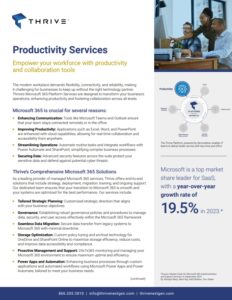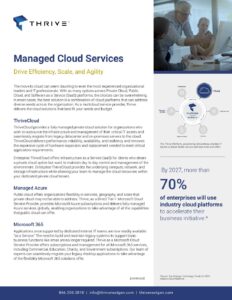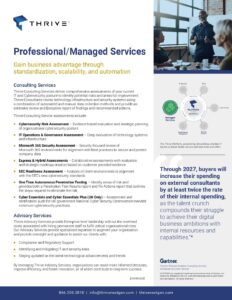Managed IT Support
Unmatched Managed IT Support
The Thrive NextGen Managed Services Platform leverages 20 years of industry, business and technology knowledge for the implementation and delivery of cloud, security, disaster recovery, networking, compliance, and workflow automation services.
With the Thrive Platform, organizations are empowered to tap into best-of-breed technologies and best practices to optimize their business performance. The Thrive Platform is further supported by technical- and compliance-focused specialists and vertical market experts that provide strategic input into each client’s tailored IT architecture.
Our Extensive Managed Infrastructure Capabilities
Organizations rely on Thrive to manage their end-user devices, including:
FIREWALLS
Features:
- Unlimited hardware maintenance & replacement
- Remote configuration & troubleshooting
- Gateway anti-virus & anti-spyware
Benefits:
- Connections to expert security management
- Access to best-of-breed technology
- Real-time threat assessment & monitoring
NETWORKING
Features:
- Comprehensive hardware monitoring, from core to edge
- Leading technology from Cisco, Fortinet, and more, managed by Thrive engineers
- Server performance monitoring & alerting
Benefits:
- Ability to achieve new levels of reliability & performance
- 24×7 monitoring
- Simplified network management & deployment
VIRTUALIZATION
Features:
- VMware certified virtualization solutions
- Server consolidated and utilization improvement management
- Single-point virtual infrastructure control
Benefits:
- Ability to reduce costs & increase utilization
- Access to trusted VMware technology
- Flexible and responsive infrastructure
SERVER & OS
Features:
- Unified support for all infrastructure systems
- Vulnerability and security scanning
- Release management & scheduling
Benefits:
- Ability to save time
- Power to reduce risk
- Capacity to maximize availability
BACKUP & RECOVERY
Features:
- Business continuity planning
- Online data protection services & solutions
- Vaulting & archiving
Benefits:
- Ability to deliver a comprehensive disaster recovery plan
- Capability to protect critical systems and data
- Capacity to meet demanding RTOs and RPOs
Broad Helpdesk Solutions
Thrive’s wide range of helpdesk solutions help organizations gain confidence in their IT infrastructure.
Microsoft 365
Thrive offers Microsoft 365 as a Cloud-based service that is designed to help meet your organization’s needs for robust security, reliability, and user productivity. We bring a managed Microsoft 365 experience that will enable your business with:
- Enterprise-class email hosting
- The latest versions of desktop productivity
- File storage and collaboration
- Optimized licensing models
Download Product Sheet


Cloud Workspace
Thrive Cloud Workspace provides Desktop-as-a-Service (DaaS), a Cloud-based service in which the back-end of a virtual desktop infrastructure (VDI) is fully hosted and managed by Thrive.
With Thrive Cloud Workspace, we provide organizations with:
- 24×7 access to desktop and applications from any device
- Simplified desktop provisioning or migration
- Ability to reduce costs, increase data security, and disaster recovery capabilities
Desktop End-User Security
Thrive delivers comprehensive and total protection for end-user devices to secure the vulnerability of your organization’s end users. In order to ensure your strategy includes an in-depth defense, as well as addresses all areas of potential weakness, our security suite includes:
- Managed security patching
- Managed anti-virus and spyware
- Advanced email security
- Cloud identity & access

Revolutionize Your Business with Managed IT Services
Our team of experts can handle all your IT needs, from cybersecurity to data recovery to compliance, enabling internal teams to get more done



